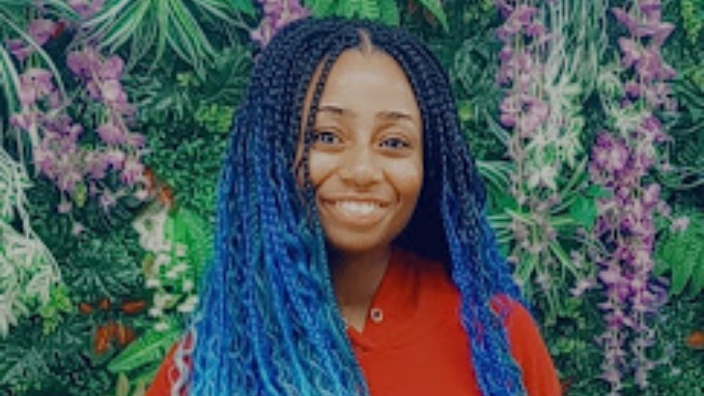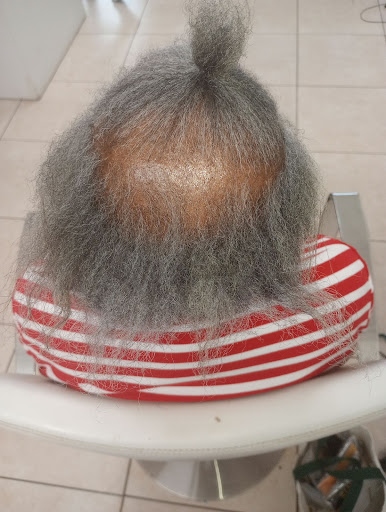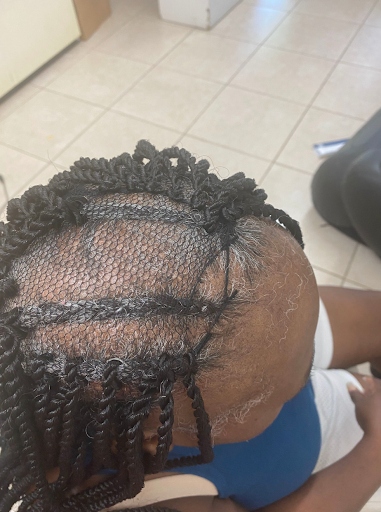‘Unheard,’ Episode Two: It’s not always about the hair
VIDEO: Kyra Pulliam shares her experiences as a Black woman living with alopecia, a disease with which she's struggled since her teen years.
Colorful deep crochet braids hang from Kyra Pulliam’s head, a style she proudly sports in order to protect her healthy thick and natural hair. However, the South Floridian has experienced difficulty in maintaining her tresses because of her struggles with alopecia.
In an interview with theGrio’s new series, “Unheard,” Pulliam discusses how she’s been battling with hair breakage since she was a teenager. However, she was first introduced to the hair-loss disease through her mother.
“I didn’t actually know the name for it, but I was kind of familiar with it because my mom had been complaining about losing some of her hair, and I thought it was just kind of like an older-person thing. One of those things that happens as you age,” says Pulliam. “But then when I noticed that I was losing my own hair, I kind of looked into it, and I realized it was a direct result of over-manipulating, overheating, over-treating my hair.”

“So, alopecia in its simplest form, by definition, just means hair loss. The No. 1 symptom what you’ll notice, are patches of hair loss. You may have either a spot in the front or you might notice a general receding of your hairline, but the most common symptom you’d see is the loss of hair. Other than that, you can also note some itching, pain, tenderness, tingling, possibly even flaking in those areas where you are experiencing hair loss,” explains Dr. Nkem Ugonabo, a board-certified dermatologist.
Dr. Ugonabo says there is more than one form of alopecia, and it can affect both men and women. Some forms can be passed down through genetics, while others may be caused by over-manipulation of the hair.
“So, there are several different forms of alopecia, and there are different categories,” she contends. “I think probably the simplest way to think about it is scarring versus non-scarring. The most common is a type of non-scarring, which is called androgenetic, also known as male pattern or a female pattern, hair loss. And that’s the kind of hair loss that you’ll often note as you get older, maybe in your 40s and 50s, tends to be hereditary sometimes.”
Pulliam says when she first discovered she had alopecia, she went through a series of hair tutorials on YouTube trying to find methods to treat her scalp. She goes on to say while many women who live with the disease do in fact go completely bald, she wasn’t ready to take that step.

“I mean, I think with someone even as beautiful as Jada Pinkett, it’s like it’s still a huge hit to your ego because it’s like we’re raised to believe that, like, hair is intrinsic to our beauty and things like that,” she maintains. “And it’s like we emphasize long hair and like growing our hair naturally and things like that. And it’s just like short hair has become more accepted. I’ve even cut my hair to about 10 lengths before, and I loved wearing that style for several years. But like, there is still this stigma against short hair involved.”
Although Pulliam had go-to braiders for years, she says it wasn’t until she found alopecia specialist Anitra Brockington that her hair really started to flourish. The stylist based out of Hollywood, Florida, shares that she didn’t start out focusing on clients who struggled with hair loss. However, after a connection with one client years ago, others quickly followed suit, including Pulliam, who found her on Craigslist.
“My first client was over 25 years ago,” says Brockington. “She came to me. I actually went to her home. This was when I was going to different people’s homes, doing their hair. And she told me she had a couple of problem issues with different parts of her hair from her using relaxers and colors over the years. And it deteriorated her scalp in her hair. And that’s when I started to learn about the alopecia epidemic. And from her, I just started gaining alopecia clients; they would, like, gravitate towards me. I don’t know where they came from, but day to day, they would say, ‘Hey, do you specialize in alopecia?’ And I would be like, ‘Yeah, so come on into my salon.'”

While Pulliam’s hair has grown back healthy and full, Dr. Ugonabo says not all types of alopecia can be reversed by treatment; specifically, the non-scarring type, where the hair follicles are not completely damaged, can be reversed.
“So, if you are evaluated early enough, and you’re able to start on different medications, you can reverse those types of treatment,” she says. “Those treatments could include anything from topical medications to oral pills that that dermatologist might suggest and can even include things like injections in the office. Sometimes we’ll do steroid injections in the areas where there is hair loss. Later on down the line, patients can often consider what’s called a hair transplant, which means essentially taking hair from parts of your scalp where the hair is still healthy and putting it in areas where you have hair loss. Most dermatologists won’t do that until you have exhausted other options, but it is something that can be considered, assuming you are a candidate for a hair transplant.”
Experiencing hair loss has not been an easy journey for Pulliam, but she expresses how grateful she is for her experience. Not only has she been able to go outside the box and test out different protective styles, but she’s also been able to fall in love with other aspects of herself.
“I kind of like to find things that I’ve always liked about myself,” she says. “It’s like my skin is beautiful, my lips, my eyes are beautiful. It’s not always about the hair.”
Check out the full episode of “Unheard” above.
TheGrio is FREE on your TV via Apple TV, Amazon Fire, Roku and Android TV. Also, please download theGrio mobile apps today!
